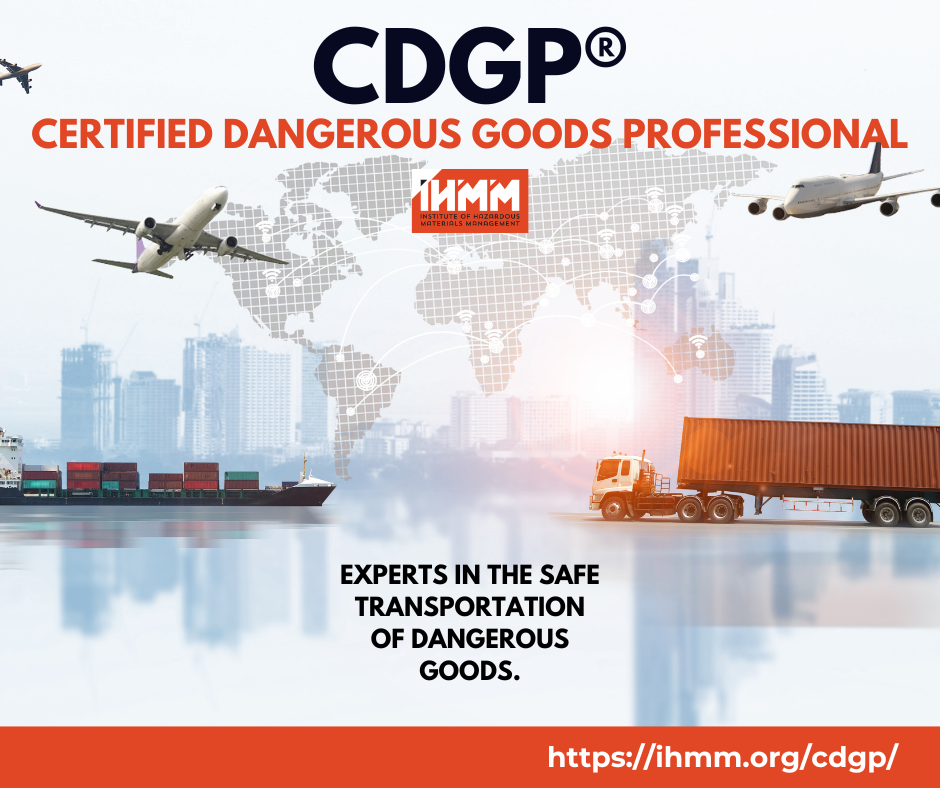DG Transportation Issues
IHMM Global DG Transport Compliance Matrix (2025–2026)
IHMM Certificant Compliance Checklist
Aligned with ADR 2025, UN Model Regulations (Rev. 24), PHMSA/HMR, ADN, and national regimes
✅ 1. Documentation & Shipping Papers
United States / Global Multimodal
- □ Confirm your shipping papers follow 49 CFR §172.201(a) sequence and may include a “Dangerous Goods” header only if the regulated description remains fully compliant. (PHMSA Interpretive Letter Ref. No. 25-0103).
- □ If shipping lithium batteries internationally, ensure you possess and can submit:
- □ UN 38.3 test report (now required at Ningbo Port, China and may be demanded elsewhere).
- □ Multimodal Dangerous Goods Declaration (IMDG/ICAO), consistent with ADR 2025 terminology.
- □ Ensure that proper shipping names (PSN), UN numbers, packing group, and special-provision references reflect ADR 2025 and UN Rev. 24 updates—especially for:
- Lithium-ion & sodium-ion batteries.
- Battery-powered vehicles/equipment.
- Waste DG (including asbestos waste, lab-smalls, and mixed inner-packagings).
✅ 2. Training & Competency
ADR / RID / EU / U.K.
- □ Verify ADR driver training certification (8.2) is current and issued by an approved training centre.
- □ Review the UK’s updated ADR driver-training guidance (13 Nov 2025) and ensure compliance for shipments starting, ending, or transiting the U.K.
- □ If operating in the U.K., monitor the DVSA RFI on hazardous-goods enforcement training—anticipate stricter roadside checks.
United States
- □ Ensure HazMat employee training meets 49 CFR Part 172, Subpart H requirements and includes:
- Classification and segregation updates reflecting UN Rev. 24/ADR 2025.
- Lithium-battery safety and documentation.
- Emergency response updates.
Asia / Latin America / Africa
- □ Verify drivers and handlers are trained to both national requirements and international DG norms (UN/ADR-based), even where domestic law lags.
- □ Ensure training includes port/terminal requirements, which may exceed national regulation.
✅ 3. Packaging, Tanks, IBCs, Vehicles
- □ Confirm packaging approvals match ADR 2025 and UN Rev. 24 updates, especially changes affecting:
- Mixed inner packagings (new ADR 4.1.1.5.3).
- Bulk wastes (asbestos, residues).
- Battery-powered vehicles/equipment (new UN entries).
- □ Inspect tank/vehicle approvals (certificates, test dates) for compliance with ADR Annex A/B.
- □ For Mexico/Latin America LNG/LPG carriers:
- □ Verify LPG units meet hydrostatic testing, maintenance records, driver competency, and GPS/speed limiter requirements instituted post-incident.
✅ 4. Mode-Specific Controls
Road (ADR / Local DG Law / 49 CFR)
- □ Ensure the documentation is physically available where required (e.g., ADR 2025 requires the transport document in the driver’s cab).
- □ Confirm vehicle marking and placarding reflect ADR 5.2/5.3 updates.
- □ Review emergency equipment inventory per ADR Chapter 8.1.
Rail (RID)
- □ Confirm harmonisation with ADR 2025 (RID follows same UN Model Regulation alignment).
- □ Verify wagon/tank certifications are current.
Sea (IMDG Code Amendment 42-24)
- □ Ensure use of IMDG 42-24 (mandatory 1 January 2026; voluntary now).
- □ Confirm segregation/packing instructions follow the 2024/2025 updates.
Air (ICAO Technical Instructions 2025–2026)
- □ Audit lithium battery compliance (marking, SoC limits, packaging PI 965–970).
- □ Ensure carrier-specific and State Variation requirements (e.g., UAE AEG-02) are respected.
Inland Waterways (ADN)
- □ Review the newly issued ADN Safety Committee 2026-series documents on:
- Determination of violations in inland waterway DG transport (ECE-TRANS-WP.15-AC.2-2026-23).
- Additional 2026-series technical updates (ECE-TRANS-WP.15-AC.2-2026-24).
- □ Map potential impact to vessels, tank barges, bulk chemical carriers, and terminals.
✅ 5. Route, Port, and Terminal Requirements
- □ Identify all ports and terminals in your DG path and confirm:
- Any document pre-clearance requirements (e.g., UN 38.3 at Ningbo).
- Terminal-specific stowage or inspection protocols.
- Additional local fire-safety, telematics or GPS mandates (common in Latin America).
- □ Include these requirements in shipper–carrier contracts and SOPs.
✅ 6. Contracts, SOPs, and Risk Allocation
- □ Ensure DG transport contracts specify the exact edition of applicable regulations:
- “ADR 2025 (ECE/TRANS/352)”
- “UN Model Regulations, Rev. 24”
- “IMDG Code Amdt. 42-24”
- “ICAO TIs 2025–2026”
- □ Add change-control clauses requiring parties to update procedures as UNECE publishes new working papers and amendments.
- □ Confirm third-party logistics providers (3PLs) have updated training and inspection obligations.
✅ 7. Internal Audits & Corrective Action
- □ Conduct internal audits for:
- Documentation accuracy.
- Driver/crew training currency.
- Packaging/vehicle certifications.
- Port/terminal documentation readiness.
- □ Implement corrective action plans aligned with ADR 2025 and upcoming UN/ADN/IMDG updates.
- □ Maintain audit logs for at least the minimum regulatory retention period (varies by jurisdiction).
✅ 8. Monitoring Obligations (Recommended for IHMM Credential Holders)
- □ Track UNECE updates for:
- ADR working papers (WP.15).
- UN Model Regs (UN-SCETDG).
- ADN Safety Committee.
- □ Subscribe to PHMSA’s Hazardous Matters bulletins.
- □ Monitor national registers:
- U.S. Federal Register (PHMSA).
- EU Official Journal.
- U.K. DfT and DVSA notices.
- ANTT (Brazil), ASEA (Mexico), GCAA (UAE), NTC (Australia), PESO/MoRTH (India), MIIT/MOT (China).
Final Counsel to IHMM Certificants
Dangerous-goods regulation is in a “quiet but tightening” phase this week: few new binding regulations, but significant interpretive, training, enforcement, and port-of-entry developments. Liability for DG shipments will increasingly turn on whether your documentation, training, packaging, and internal controls reflect ADR 2025 / UN Rev. 24 / IMDG 42-24 / ICAO 2025–2026—even in jurisdictions that have not yet formally amended their domestic law.



Leave A Comment